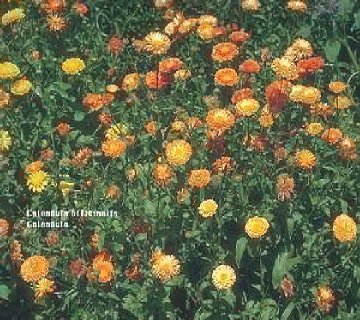
Calendula
Calendula officinalis
Chris Sugg and Mike Wiggins

Folk Names
Pot Marigold
Marigold
Marybud
Gold-Bloom
General Description
Single or double flowers in shades of yellow, orange and gold
Can grow up to 18 inches high
Thrives in mild, cool weather, full sun or light shade, and well-drained fertile soil
History and Folk Use
Originated in Egypt with documented use as early as the 12th century
Historical uses:
Astringent
Antiseptic
Antifungal
Anti-inflammatory
Wound healing
Menstrual regulator
Stimulation of bile production
Historical beliefs:
When marigolds are picked at noon (when the sun is hottest and strongest) they will serve to strengthen and comfort the heart.
Garlands of marigolds strung on the door posts will stop evil from entering the house.
Marigolds scattered under the bed will protect the sleeper and make his or her dreams come true.
Adding marigolds to bathwater helps to win the respect and admiration of everyone you meet.
Looking at the bright flowers of marigold will strengthen sight.
Marigold carried in the pocket helps justice smile favorably upon you in court.
Chemical Composition
Triterpenoids (faradiol)
Oleanolic acid glycosides
Sesquiterpene glycosides
Sapsonins
Flavonoids
Essential Oils
Steroidal compounds
Both the petals and flowerheads are harvested for medicinal purposes.
Pharmacology
Anti-inflammatory
Astringent
Emmenagogue
Uterotonic properties
Antimicrobial
Antiviral
Despite its long history of use, there are almost no studies regarding the efficacy of calendula in humans. Used topically, a 5% flower extract has demonstrated stimulation of epithelialization in surgically-induced wounds. The mechanism of this effect is believed to include collagen stabilization and increased glycoprotein.
Clinical Applications
Local skin problems (used as a lotion or compress)
Inflammation (whether due to infection or physical damage)
Wounds
Bruises
Strains
Minor burns
Scalds
Chronic hyposecretory gastritis, digestive inflammation, or ulcers
Indigestion
Fungal infections (internal and external)
Female complications
Helps in delayed menstruation and painful periods
Toxicology
There have been no reports in Western literature describing serious reactions to the use of calendula
In Russia, there was one report of anaphylaxis in a patient who gargled with calendula.
Doses up to 50 mg/kg have shown no histopathologic changes.
As with any agent, the risk of allergic reaction is possible. Risk for allergic reaction is more likely in a patient with allergies to chamomile, feverfew, or dandelion pollen. When used topically, the reaction is generally a self-limited contact dermatitis.
Disease Interactions
Pregnancy
Calendula produces uterine contractions
Calendula may modify cell membrane structure, possibly leading to hemolysis and subsequent cytotoxic effects on the host.
Glaucoma
May increase intraocular pressure
Dosage
Anti-inflammatory or menopausal problems
Infusion: 1-2 teaspoons of crushed petals infused in water for 10-15 minutes three times daily
Wound healing
Compress: Apply a pad soaked in the infusion (described above)
Oral ulcers and gum disease
Mouthwash: Gargle the infusion
Dry skin or skin inflammation
Cream: Apply twice to three times daily
Hemorrhoids and broken capillaries
Infused essential oil
Yeast infections
Suppositories: 2-5 drops each of marigold and tea tree oils, one to two times daily
Depression
Essential oil: Add to bathwater
Study:
The in vitro anti-HIV activity of calendula extract was examined. Extracts of dried flowers were examined for their effect on HIV-1. Both the organic and aqueous extracts were shown to be non-toxic to human lymphocytes. However, only the organic extract (500 mcg/mL) exhibited potent anti-HIV activity. Infected T-cells were protected up to 24 hours from fusion and subsequent death. Calendula extract also caused a dose-dependent reduction of HIV-1 reverse transcriptase activity. After a 30 minute treatment, 85% of reverse transcriptase inhibition was achieved. This has sparked an interest in the therapeutic use of calendula in HIV infection.
Other in vitro studies of calendula have suggested that it is anti-inflammatory and antimutagenic. One study in humans suggests that calendula may be able to alleviate gastric pain due to duodenal ulcers or gastroduodenitis.
Summary
References
The Lawrence Review of Natural Products. "Calendula" Jan 1995 monograph.
Antimutagenic activity of some sapsonins isolated from Calendula officinalis. Mutagenesis, 5(4): 37-331, 1990.
The role of triterpenoids in the topical anti-inflammatory activity of Calendula officinalis flowers. Medline 1994 Dec; 60(6): 516-20.
Anti-HIV activity of extracts from Calendula officinalis flowers. GlaxoWellcome 1997; 51(4); 176-80.
Weinberg, Carol. The Culture of Herbs and Spices. Oxford Press 1996.
Hoffman, David. Herbal Materia Medica. Health world, "Calendula officinalis."
Ody, Penelope. The Complete Medicinal Herbal, "Marigold," 1993, p. 43.
Internet Sites:
http://www.arsenic.com/prevherb/marigold.html
http://www.hotwired.com/drweil/search/burns.html
http://www.citysource.com/Shops/HFCoop/herb796.html